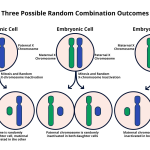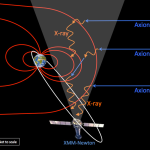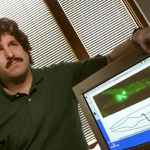The emergence of the topological qubit marks a significant milestone in the realm of quantum computing, promising to revolutionize how we approach complex computational challenges. Unlike traditional qubits, which often struggle with maintaining superposition and stability, topological qubits offer a promising solution by leveraging unique properties to enhance resilience against errors. This advancement is a culmination of years of research led by experts, including Chetan Nayak from Microsoft, who discussed its implications during a recent interview. Microsoft’s topological qubit is poised to power ultrafast quantum computers that can tackle problems far beyond the reach of current supercomputers. With breakthroughs in quantum error correction and the design of Microsoft’s quantum chip, we are witnessing a new frontier in technology that could redefine our computational capabilities.
When we discuss advanced quantum systems, we often encounter terms like ‘novel qubits’ or ‘exotic qubits,’ which underline the transformative potential of innovations like the topological qubit. This sophisticated approach to quantum bits seeks to stabilize qubit states, allowing for longer coherence times and decreased susceptibility to environmental disturbances. Notably, the work done by leading figures such as Chetan Nayak is paving the way for the next generation of quantum processors, which may incorporate these topological features to improve upon conventional designs. By enhancing superposition capabilities and implementing more efficient quantum error correction mechanisms, the future of quantum computing is beginning to look increasingly promising. As we continue to explore the intricacies of these advanced qubit systems, the implications for fields ranging from cryptography to materials science become vastly exciting.
Understanding Topological Qubits in Quantum Computing
Topological qubits represent a significant advancement in the realm of quantum computing, disrupting traditional notions of qubit functionality. Unlike conventional qubits, which are susceptible to environmental noise and decoherence, topological qubits leverage the principles of topology to maintain stability in their quantum states. Chetan Nayak’s innovative work at Microsoft illustrates how these qubits encapsulate quantum information in a more resilient form, thereby enhancing their ability to perform complex calculations. This resilience is crucial in the race to create quantum computers capable of addressing engineering, materials science, and medical applications that defy the limitations of classical supercomputers.
The development of Microsoft’s topological qubit stems from cutting-edge research into materials science, utilizing indium arsenide and aluminum to create a superconductor at ultra-low temperatures. This unique composition allows for the demonstration of quantum superposition in a more durable state, which could potentially enable qubits to perform calculations that leverage the power of quantum entanglement more effectively. By minimizing the interference of external factors and maximizing coherence times, topological qubits pave the way for operational improvements in quantum error correction techniques, representing a transformative leap in quantum information processing.
The Role of Quantum Error Correction in Quantum Computing
Quantum error correction is a vital component for the successful implementation of quantum computers, especially as the industry moves towards building larger quantum processors like Microsoft’s million-qubit vision. As quantum systems, including topological qubits, are inherently fragile, the introduction of error correction protocols becomes necessary to mitigate the degradation of quantum information. By using specific algorithms and redundancies tailored for quantum architectures, researchers can effectively detect and correct errors that might arise from environmental interactions, thus preserving the delicate superpositions that characterize quantum states.
In discussions led by experts like Chetan Nayak, the necessity of integrating quantum error correction into the hardware level of quantum devices has come to the forefront. Establishing error correction at this stage can significantly enhance the reliability and processing capabilities of quantum computers. As the quantum landscape evolves, understanding and implementing these correction mechanisms will be as crucial as advancements in qubit technology itself, ensuring that quantum computers can reach their full potential without succumbing to errors generated by noise and decoherence.
The Promise of Ultrafast Quantum Computing
Ultrafast quantum computing marks a paradigm shift in computational capabilities, promising to solve complex problems at speeds unattainable by classical systems. Microsoft’s recent revelations regarding their topological qubit suggest that this technology could underpin the next generation of quantum processors, enabling calculations that delve into intricate scientific inquiries, including materials discovery and pharmaceuticals. By harnessing the principles of superposition and entanglement, ultrafast quantum computers can execute operations that would traditionally require millions of years for classical supercomputers, leading to revolutionary advancements across various fields.
As Chetan Nayak explains, the integration of topological qubits into a larger quantum architecture aligns with a strategic roadmap aimed at achieving practical quantum computing solutions. This roadmap outlines milestones not only for increasing qubit counts but enhancing operational reliability through innovations like quantum error correction. The goal is to build robust quantum systems that can tackle problems in real-time, providing insights that accelerate scientific and technological progress—transforming industries by enabling more efficient processes and fostering groundbreaking discoveries.
Chetan Nayak’s Vision for the Future of Quantum Computing
Chetan Nayak’s vision extends beyond mere technological advancement; he envisions a future where quantum computing fundamentally alters our understanding and interaction with complex systems. Through his collaboration with Microsoft, Nayak aims to overcome the traditional boundaries of computation by developing scalable quantum computers that can perform tasks previously thought impossible. By focusing on topological qubits and fostering strong partnerships with governmental and academic institutions, he is positioning quantum computing as a key driver for economic and scientific growth.
By envisioning a quantum landscape characterized by stability and efficiency, Nayak and his team offer a beacon of hope for a world grappling with increasingly complex challenges. The potential applications of ultrafast quantum computing are profound, especially in addressing critical issues such as climate change, drug discovery, and high-efficiency materials design. With a dedicated pursuit to achieve a million-qubit system, Nayak’s vision embodies not only ambition but also a tangible plan that could redefine computation in the coming decades.
The Challenges of Building Practical Quantum Computers
Building a practical quantum computer poses numerous challenges, particularly concerning the delicate nature of qubits and their susceptibility to errors. As seen with traditional computational devices, the initial hurdles faced by quantum researchers mirror those encountered during the early days of semiconductor technology. Chetan Nayak emphasizes that to effectively realize the potential of topological qubits, a thorough understanding of material science and quantum mechanics is paramount. Engineering suitable materials that can successfully host these new states of matter requires innovative thinking and experimental rigor.
Moreover, the integration of error correction methods is not just a technical hurdle; it is also foundational for achieving fault tolerance in quantum systems. As Nayak notes, the ongoing development of topological qubits serves as a means to embed error resistance at the hardware level. This could alleviate many practical issues faced in quantum computation today, allowing for the large-scale implementation of quantum processors essential for a variety of applications—from optimizing supply chains to simulating molecular interactions that could lead to drug breakthroughs.
The Next Steps for Microsoft Quantum Technology
As Microsoft endeavors to push the boundaries of quantum technology, ongoing research and collaboration are essential. Nayak indicates that the company’s strategy includes refining topological qubit technology to eventually develop robust systems capable of fulfilling their ambitious roadmap for quantum computing. In the imminent future, we can expect to see advancements in the integration of these qubits into scalable architectures, as well as improvements in error correction protocols to achieve higher operational fidelity.
In moving forward, Microsoft’s collaboration with agencies such as DARPA signals a commitment to not only achieving scalable quantum systems but also ensuring practical applications in diverse fields. This shared knowledge emerges from rigorous testing, which is instrumental in the iterative process needed to advance quantum technology. By making substantial progress on their roadmap, Nayak’s team positions themselves as leaders in the quantum race, ultimately striving to make quantum computing available for real-world applications in the near future.
Chetan Nayak on the Importance of Collaboration in Quantum Research
Collaboration stands as a critical component in advancing the field of quantum computing, as highlighted by Chetan Nayak’s insights from his experiences at Microsoft and in academia. Engaging with diverse groups, including researchers from other institutions and industries, fosters innovation and accelerates the pace of development. Through platforms such as the Station Q conference, Nayak showcases the value of dialogue and synergy among different stakeholders, emphasizing how collective expertise can overcome individual challenges.
Moreover, the cross-pollination of ideas between academia and industry can lead to breakthroughs that propel quantum computing closer to reality. By nurturing partnerships, researchers like Nayak aim to cultivate an ecosystem conducive to sharing knowledge and resources, thereby diminishing the barriers which often slow technological advancement. The encouragement of active discourse among physicists, engineers, and computer scientists is vital for the continuous evolution of quantum technologies and their successful implementation in solving pressing global issues.
The Significance of Superposition in Qubit Technology
Superposition lies at the heart of quantum mechanics, shaping the framework for how qubits function within quantum computing paradigms. By enabling qubits to exist simultaneously in multiple states, superposition enhances computational parallelism, vastly improving processing power compared to classical bits. This critical principle allows quantum computers to perform numerous calculations at once, leading to faster and more efficient problem-solving capabilities. Chetan Nayak’s work with topological qubits builds directly on this concept, demonstrating how robust qubits can maintain their superposed states through advanced material engineering.
The realization of superposition stability is essential for attaining coherent quantum computing. With stronger qubits such as topological qubits, which resist environmental fluctuations better than traditional qubits, researchers expect a higher fidelity of computations. This translates into quicker, more accurate results when addressing complex computational tasks. As quantum computing continues to evolve, the ability to utilize superposition effectively will be crucial for unlocking transformative applications across various domains, from cryptography to machine learning, thus expanding the boundaries of what is computationally feasible.
Reflecting on the Evolution of Quantum Computing
Reflecting on the evolution of quantum computing reveals both the monumental challenges and the groundbreaking achievements that have characterized this field over the past few decades. The shift from vacuum tubes to semiconductors represents a parallel to the current advancements in qubit technology, such as the transition toward topological qubits. As researchers like Chetan Nayak contemplate the future of quantum systems, it’s evident that the journey is ongoing and fraught with complexities that demand innovative solutions to material and technical challenges.
The landscape of quantum computing is continually shifting, driven by both theoretical developments and practical implementations. With promising technologies emerging from companies like Microsoft, the future holds significant potential for breakthroughs that could redefine our approach to solving complex computational problems. As Nayak and his team pursue their ambitious vision, the lessons learned from past technological revolutions serve as both inspiration and a roadmap to guide current efforts toward practical quantum computing in the years to come.
Frequently Asked Questions
What is a topological qubit and how does it impact quantum computing?
A topological qubit is a type of qubit that utilizes the principles of topology to enhance stability against errors, making it a promising candidate for quantum computing. Unlike conventional qubits, which can lose their quantum state due to environmental interference, topological qubits maintain their information longer, facilitating quantum error correction and leading to more reliable, ultrafast quantum computers.
How does a topological qubit differ from traditional qubits in quantum computing?
Traditional qubits, such as those based on superconducting circuits or trapped ions, are susceptible to noise and loss of coherence. Topological qubits, developed by Microsoft, are designed to leverage topological properties to protect quantum information, resulting in a more robust system that reduces error rates and enhances the performance of quantum computers.
What role does superposition play in the function of topological qubits?
Superposition is a fundamental property of qubits, allowing them to represent multiple states simultaneously. In topological qubits, superposition is preserved more reliably due to their inherent stability against external disturbances, which is essential for executing complex quantum computations without rapid decoherence that typically plagues conventional qubits.
What advancements did Chetan Nayak contribute to the development of the topological qubit?
Chetan Nayak, a key figure at Microsoft, has led significant research and development efforts towards creating topological qubits. His work focuses on understanding and harnessing unique material properties, specifically within indium arsenide and aluminum, to engineer qubits that can operate at low temperatures while exhibiting enhanced stability and capability for quantum error correction.
How might Microsoft’s topological qubit accelerate quantum computers beyond classical computers?
The topological qubit is expected to enhance the speed and efficiency of quantum computers by reducing error rates and improving coherence times. This pragmatic approach enables the creation of a million-qubit system that could tackle problems currently unsolvable by classical supercomputers, achieving tasks such as simulating complex chemical reactions and optimizing large-scale computational problems.
What are the potential applications of topological qubit technology in quantum computing?
Topological qubits can potentially revolutionize various fields, including materials science, chemistry, and cryptography, by enabling complex simulations and computations. Their superior stability and error resilience could facilitate breakthroughs in developing new materials, efficient chemical processes, and secure communication systems within quantum computing.
What challenges remain in the development of topological qubits for practical quantum computing?
Despite their advantages, the practical implementation of topological qubits faces challenges such as material engineering, scaling up the technology to millions of qubits, and integrating them into functional algorithms. Strong collaboration between theoretical research and practical experimentation is essential to address these challenges and move towards viable quantum computing solutions.
What is quantum error correction, and how is it related to topological qubits?
Quantum error correction is a crucial technique designed to protect quantum information from decoherence and loss of fidelity. Topological qubits inherently support quantum error correction through their robustness against noise, which means they can sustain information longer, allowing for more dependable quantum computations over time.
How close is Microsoft to creating a fully operational quantum computer using topological qubits?
Microsoft is actively working towards developing a fully operational quantum computer powered by topological qubits. Currently, they are testing prototypes and have set a roadmap for scaling up the qubit count to a million, with plans in place to demonstrate significant progress in fault-tolerant quantum computing within a short time frame.
Why is the discovery of topological qubits significant for the future of quantum computing?
The discovery of topological qubits marks a pivotal advancement in quantum computing by offering a more stable approach to building qubit systems. This could lead to usable quantum computers that outperform classical machines in solving complex problems, ultimately pushing the boundaries of technology and computation.
| Aspect | Details |
|---|---|
| Innovation | Microsoft’s development of the topological qubit, which offers enhanced stability and robustness. |
| Implications | Expected to significantly advance quantum computing, surpassing existing supercomputers. |
| Technical Composition | Made up of indium arsenide and aluminum, and operates at extremely low temperatures as a superconductor. |
| Key Advantages | Allows for more efficient quantum error correction due to inherent stability, minimizing loss of superposition. |
| Future Aspirations | Aiming to develop a million-qubit quantum computer to address complex problems in materials and chemistry. |
| Challenges Faced | Researchers faced significant hurdles similar to early classical computing, requiring extensive material research. |
Summary
The emergence of the topological qubit signifies a pivotal development in the realm of quantum computing. This innovative qubit is designed to be more stable and robust compared to traditional quantum bits, aiming to address complex computational challenges with unprecedented efficiency. By harnessing the unique properties of its material composition, Microsoft positions itself at the forefront of quantum technology, promising advancements that could transform industries reliant on high-speed computation. As researchers continue to refine their approach, the potential of topological qubits may unlock solutions to significant scientific queries, redefining the future of quantum computing.








